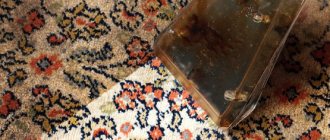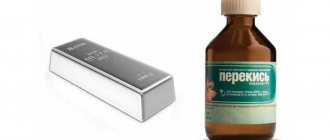Rinse with hot water under the tap with good pressure:016:
washed it, didn’t help, apparently stuck well
Plumbing cable. The first link that came up: https://www.cheb-tros.ru/
Long knitting needle. Just push through with thick wire.
Plumbing cable. The first link that came up: https://www.cheb-tros.ru/
Long knitting needle. Just push through with thick wire.
they tried to push it with a plastic tube, on which balloons are attached, but apparently this small infection was of such a diameter that it was sucked in, but it was difficult to go back, the tube moved it from its place, but not far you need to forcefully push the plumbing cable along the entire length Most likely it will work, but it will probably be expensive, can you tell me?
Cleanliness in the house is an important condition for maintaining housing.
Dust settling on carpets, laminate, and parquet is a habitat for pathogenic microorganisms and is dangerous to human health.
You can effectively remove dirt from the floor using a vacuum cleaner . However, by regularly coming into contact with particles of debris, this device itself quickly becomes dirty and requires cleaning.
Causes of pollution
The most susceptible to clogging are the working brush attachments, the telescopic handle and the suction hose of the device. The main reason for the formation of dust accumulations on these elements is cleaning surfaces with a high degree of contamination - food debris, candy wrappers.
To avoid deterioration in the quality of the vacuum cleaner or its failure, before using it, first sweep all large debris from the floor with a broom.
The main reasons for contamination of the device:
- insufficient care of the device (irregular emptying of the dust container);
- loose connection of filters to the housing;
- use of damaged dust collectors - if the integrity of the bag or container is damaged, particles of debris penetrate into the “heart” of the device - the electric motor, which can lead to its breakdown.
IMPORTANT! If it is necessary to clean the room after renovation work, first sweep up construction debris and then remove any remaining small dirt with a vacuum cleaner.
Operating rules
To extend the service life of an electrical appliance, you must follow the operating instructions recommended by the manufacturer. However, there are general recommendations, regardless of the brand, that are suitable for both the Dyson and Raketa vacuum cleaners:
- maximum continuous operation time - no more than 1 hour;
- Do not press the nozzle too hard against the surface;
- decreased draft is a signal for urgent cleaning of all elements of the vacuum cleaner;
- it is important to observe safety precautions when working with electrical appliances;
- Clean the filters at least once a month.
Thus, cleaning the filters plays an important role in the long-term service of the vacuum cleaner. The accumulation of dirt and dust inside an electrical appliance will not only negatively affect the operation of the vacuum cleaner, but will also significantly reduce the quality of indoor air.
Source
How often to clean?
How often you clean your device depends on several factors.:
- area of the premises, number of people living, presence of pets;
- intensity of use of the device and type of vacuum cleaner.
When processing large areas, shake out the contents of the container or garbage bag after each use of the vacuum cleaner.
If the house is small, emptying the dust container every 3 cleanings will be sufficient.
In a room where several people live or where there are pets, the vacuum cleaner usually has to be used daily. Therefore , at least once every six months, carry out a complete cleaning procedure for the device.
Also, the number of cleaning procedures for a vacuum cleaner depends on its design features: if the device is equipped with an aquafilter, wash the dust collection container after each cleaning. Shake out reusable bag devices when they are 2/3 full of trash.
The need to clean the vacuum cleaner is indicated by spontaneous shutdown of the device during operation.
The device stops due to overheating of parts and components, which can be caused by the following reasons:
- clogging of the inlet or flexible hose;
- accumulation of contaminants on the filter elements;
- clogging of the motor.
A sign indicating the need to wash the vacuum cleaner is a deterioration in its suction properties.
Step-by-step instructions for complete disassembly
Partial disassembly is performed when replacing or cleaning filters, but in order to remove the engine, it is necessary to disassemble the device completely. We offer detailed photographic disassembly instructions that will help you cope with the repair of the Samsung vacuum cleaner yourself.
Stage #1 - we diagnose the breakdown
When you use one device for a long time, you can perfectly imagine how it behaves during operation.
An experienced user does not need to look at the bag or tank full indicator; it even determines by sound when it is time to empty the dust container or filters. Consequently, he will also determine the fact of a malfunction by the unusual behavior of the assistant.
If an overfilled vacuum cleaner begins to hum or hiss, then a mechanism with a broken motor or board makes intermittent sounds, begins to “spit” dust, smells like burnt wires, or simply does not respond to being plugged in.
If you doubt the serviceability of the vacuum cleaner, you can try to disassemble it. This is a simple procedure that does not require special knowledge or special skills. As instructions, you can use videos or photo instructions from craftsmen, carefully filmed by them and posted on the Internet.
Stage #2 - selecting tools and materials
To disassemble the vacuum cleaner body, you do not need to purchase a special tool. Most likely, a pair of screwdrivers, Phillips and slotted, which can be found in the household of any city dweller or rural resident, will come in handy.
No tools are required to disassemble the filters as this is a regular maintenance procedure. You just have to manually remove the covers or open the plastic boxes.
On some models, to change the HEPA filter, you need to remove the rear grille by unscrewing 2-4 screws, also using a screwdriver.
But if manipulations with the motor, board elements, and wires are to be done, the following tools and materials may be required:
- pliers;
- file;
- awl;
- sandpaper;
- vice;
- construction knife;
- spare connectors and wiring.
Small parts are inexpensive, but a faulty engine requires replacement - an average of 1,650-2,600 rubles.
Instead of an expensive original part, you can look for an alternative mechanism, but you should pay attention to the materials from which it is made.
Stage #3 - disassemble the vacuum cleaner body
It often happens that during the process of disassembling the device there is a problem, that is, the cause of the breakdown is not necessarily a failed engine. The thermal relay connector may have come loose or there may be damage to the board.
All actions can be performed by an untrained person, since disassembling this model requires attention, accuracy and the ability to use screwdrivers - flat and Phillips.
A vacuum cleaner is one of the most common household appliances and is found in every home. Being an indispensable assistant in cleaning premises, the unit itself also requires constant care. Therefore, the quality of cleaning and the service life of the device depend on how correctly and timely its cleaning is carried out.
Preparatory stage
Before starting to disassemble the device, put on an apron and rubber gloves.
To prevent dust from getting onto the floor when disassembling the vacuum cleaner, use a small piece of polyethylene (100x100 cm) or oilcloth as a bedding.
To clean the device directly, prepare detergent, a stiff sponge, and a microfiber cloth.
What do you need for work?
Proceed to disassemble the device (according to its instructions):
- disconnect the device from the power supply, wait until the case cools down after work;
- place the vacuum cleaner on the spread polyethylene;
- wipe the cord with a slightly damp cloth and wind it up;
- open the case, remove the dust container;
- Clean the outer and inner surfaces of the vacuum cleaner body with a damp cloth and wipe the lid.
Pay special attention to the holder (the bag fastening part) - if debris remains on it, the hose will enter the hole with an offset and dust will penetrate inside the vacuum cleaner during the cleaning process.
Some tips
You learned how to clean a Samsung vacuum cleaner. For other vacuum cleaners, the cleaning procedure will not be much different, so here is a short list of tips that apply to almost all vacuum cleaners:
- Wet clean filters and containers only if specified by the manufacturer. If you are not sure that it is possible to clean your LG vacuum cleaner with water, hold off on such methods until you find out the exact information.
- If you are tired of regularly cleaning the device, you can purchase separator-type units. Such vacuum cleaners require the least amount of “cleaning” and cope with the tasks effectively.
- Observe safety precautions if you are going to disassemble the device. First of all, turn off the power, and only then take on the structure itself.
- Is the electrical appliance not used very often? It would be more rational to purchase disposable bags if the design of your vacuum cleaner model allows you to work with them.
Important! The appearance of dust on the surface of furniture is the first sign that it is time to clean your home. In order to collect dust, and not raise it into the air, special products are used, which, in addition to their main function, are also furniture polish. After studying all consumer reviews, we have compiled a rating of the best dust collection products especially for you.
A broken home vacuum cleaner can dramatically change your plans, ruin your mood, and even reduce your family budget. However, you shouldn’t immediately jump on the bandwagon and go looking for a more reliable replacement. You can try to repair the unit at home. This solution to the problem will save a considerable amount, don’t you agree?
Parts care
Cleaning nozzles, pipe and hose
To clean the suction hose and working brush attachments, follow these steps::
- fill the bathtub with warm water;
- disconnect the hose from the vacuum cleaner and place it in the liquid for 10 minutes;
- after the specified time, clean the inner surface of the pipe with a long rod or steel wire, wipe the outer surface with a hard sponge;
- remove the hose from the water and place it on a spread oilcloth to dry.
To remove build-up of dust, fur, and hair from the brush heads, adjust the brush switch so that the bristles extend and remove debris using tweezers, scissors, or an old toothbrush.
After this, fill the container with water and add detergent or soap, place the nozzle in the resulting solution for 15 minutes, then wipe it with a hard sponge, rinse with clean water and leave to dry.
Blowing the motor
- remove all filters from the vacuum cleaner, close the housing and take the device to an open space (for example, a balcony); turn on the device and set the power switch to maximum;
- After 15-20 minutes of operation, unplug the device, let it cool and wipe it with a damp cloth.
REFERENCE! The process of cleaning dust inside will be more effective if you tilt the vacuum cleaner slightly in different directions while blowing and cover (not completely) the hole to which the hose is connected.
Removing the smell
If not maintained regularly or due to moisture or food debris getting into the dust collector, the vacuum cleaner begins to smell unpleasant. Also, an odor may appear if dirty water stagnates in the aquafilter.
To get rid of this problem, remove the dust collection device and the engine protection filter and wash it with soapy water.
To eliminate the smell, use fragrance balls, which you place in the dust container and leave there until it is empty.
Aromatherapy can be easily done at home:
- mix wine vinegar and warm water in equal parts; disassemble the vacuum cleaner and treat the entire inside of the device with the solution;
- wait until the unit dries, then apply 5-6 drops of any essential oil to a cotton pad and place it in the dust collector.
Cleaning process
To get rid of dirt inside the vacuum cleaner, you need to follow these instructions:
- Turn off the power to the device.
- Remove the hose and remove all filters: dust bag, filter, motor and final filter.
Important! The vacuum cleaner model may have additional filters, which also need to be removed.
- Clean the dust collector chamber from dirt using a damp cloth. Carefully wipe all parts, cracks and gaps where dust may accumulate.
- Clean the engine compartment by plugging in the vacuum cleaner and blowing air through it.
Important! The dust cleaning process will go faster if you tilt the device slightly when blowing and open and cover the hole that is intended for connecting to the hose with your hand.
- Replace old filters and bags with new ones if for some reason they become unusable. Reinstall all components.
- Clean the turbo brush, nozzles, and other components used for cleaning. All foreign objects and particles must be removed. To remove, you can use thin sharp objects or tweezers.
Important! Be careful when using sharp objects. Try not to damage the household electrical appliance.
Mercury removal
Metal vapors entering the body of a living creature during breathing are distributed throughout all organs and accumulate in them, causing poisoning, nausea, shortness of breath, increased body temperature, and damage to the central nervous system.
Therefore, if a mercury thermometer in your home was broken, there is a chance that metal particles got into the vacuum cleaner .
While the device is operating, the mercury will begin to evaporate, but even when turned off, the vacuum cleaner will create a toxic background.
To make sure that the substance actually got into the electrical appliance, use a test strip: disassemble the vacuum cleaner and place all the parts in a plastic bag, place the test there with the reagent facing up. If the concentration of mercury vapor is high, the strip will turn light gray after 2 hours.
In this case, it is necessary to clean the electrical appliance using a liquid demercurizer:
- assemble the vacuum cleaner, put on hoses, nozzles, connect the device to the network;
- prepare the preparation or use a manganese solution (dissolve 2 g of potassium permanganate in 1 liter of warm water), spray the liquid into the air suction hose, wait 1 minute and turn off the vacuum cleaner;
- disassemble the electrical appliance and place all parts outdoors for a week.
If the next test shows the presence of mercury vapor, the vacuum cleaner needs to be replaced.
You can also call specialists (demercurizers) to your home to remove metal from an electrical appliance.
Carefully following all recommendations and operating rules for the vacuum cleaner will allow you to use this device for a long time without breakdowns or repairs. Regular, simple maintenance of the equipment will ensure the preservation of all technical characteristics of the device and high quality cleaning.
Minor faults and their elimination
If the vacuum cleaner begins to act strangely - to perform its functions incorrectly, to make loud noise, to vibrate - it needs help.
Most often, the cause of the malfunction is the cleaning process itself: the dust bag is completely filled or one of the filters is clogged with debris.
Some vacuum cleaners are easy to disassemble, while others require certain knowledge. To avoid mistakes, we recommend that you often look at the instructions, which are equipped with diagrams and tips.
You can often repair a vacuum cleaner on your own, but if you are not good at repairing equipment, it is better to take the device to a service center or specialists.
Problem #1 - suction power has dropped sharply
If you notice that dust is poorly absorbed, and small debris remains completely untouched on the floor, you will have to find out the reason through partial disassembly. First you need to make sure that everything is in order with the pipe, hose and brush.
- disconnect the hose from the vacuum cleaner;
- separate the pipe from the hose;
- remove the nozzle;
- carefully inspect each part;
- try to blow out the pipe and hose.
If a large object (a plastic bag, a sock, a sheet of paper) gets into one of the elements, you need to carefully remove it, then reassemble it in the reverse order and try to start the device.
Sometimes the traction weakens simply because you accidentally touched the power regulator and set it to minimum. Be sure to check it before any disassembly. Another reason for weakening traction is a broken hose.
Problem #2 - the vacuum cleaner filters are clogged
Unusual sound, weak traction, stoppage of operation - the consequences of clogged filters. For devices with a fill indicator, this can also be determined by the red light coming on. Modern devices provide everything to ensure that filters can be accessed quickly and easily.
Usually there are two main elements that need to be cleaned - a plastic cyclone filter (a transparent reservoir with compartments) and a sponge enclosed in a plastic container. But sometimes it is necessary to replace the HEPA filter, and for washing units - additional engine protection.
Photo tips for disassembly, cleaning and replacement:
As you can see, disassembling a Samsung vacuum cleaner to clean the filters is simple and quick. The elements are washed in warm water with a non-aggressive detergent. Then they need to be dried and reassembled.
Problem #3 - the device does not turn on
The standard test when the device is not working is to plug it into the network. Make sure the power cord is plugged into the outlet and the power control button is set to the correct setting.
How to clean a vacuum cleaner filter?
Before you start cleaning the filter, you need to study the technical characteristics of the device, because there are several types of filters, and each type is cleaned differently:
- Filter bag . Made of synthetics (reusable) or paper (disposable). To clean the filter bag, you need to remove it from the vacuum cleaner, rinse it under running water, dry it and place it in its original place. A synthetic filter can also be placed in a bowl of water, wait a while until all the dust has settled, and rinse the bag under water, dry it and place it in its original place.
- Aqua filter (water) . The dust is moistened here and settles to the bottom of a special container. It is recommended to rinse such water filter containers with water, and vacuum or rinse the filters themselves, then dry them and return them to the vacuum cleaner.
- Cyclone filter . Vacuum cleaners with such filters have special containers for large debris and dust. Cyclone filters must be cleaned after each cleaning. To do this, wash the plastic garbage container and microfilters.
You can clearly see how to clean the filter of a Doffler vacuum cleaner in the following video:
Types and methods of cleaning filters
To prevent debris passing through the vacuum cleaner from clogging the turbine and escaping back into the room, several degrees of filtration are installed inside the electrical appliance: coarse cleaning, motor filter and exhaust air filter. Depending on what type of dust collector requires cleaning, it is worth choosing a cleaning method.
Pouch
Bag filters come in several types: paper, synthetic, fabric. Paper and thin synthetic filters cannot be cleaned. These types are disposable and must be removed from the vacuum cleaner and new ones installed when they reach the limit of contamination. These filters are enough for several cleanings; on average, their service life is about a month.
Fabric bags can be shaken out and washed. The mounting base of such bags is usually made of plastic and has a rubber cuff inside. Cleaning can be done with air. To remove the filter bag, you will need to open the cover on the front of the panel or a separate compartment designed for this (depending on the model). The bag can be secured with a latch or clothespin.
Water
Aquafilter is one of the most effective types of filters in modern generation vacuum cleaners. It is assumed that all dust particles remain in the water. Cleaning consists of replacing dirty water with new water and washing the filter walls. Dust masses enter the aquafilter from above, and only 1/3 of the filter should be filled with water.
The absorption of air by the container is carried out in such a way that between the hose and the turbine there is not only a partition, but also a whole layer of water. The entrance and exit are not interconnected, everything is hermetically sealed. Thus, the dust passing through the water barrier gets wet and remains inside, only clean air comes out back.
See also
TOP 27 means and methods for cleaning copper at home
Cyclonic
It is a plastic container that vaguely resembles a teapot. The principle of operation of the cyclone filter is based on centrifugal force: debris is pressed against the walls and held tightly due to the action of air flows. This dust collector is easy to clean. To do this, you need to remove the container from the vacuum cleaner. For minor contamination, simply shake out the debris.
HEPA filter
Modern hepa filters are available in paper (disposable) or polymer. The latter are easy to clean: large dust particles are removed with a hard bristle brush, after which the filter is washed with water. To remove it, you will need to open the lid of the vacuum cleaner, in the part where the dust collector is located (it is first important to disconnect the electrical device from the power supply), and remove the filter.
One of the dust collectors can be installed at the bottom of the device. In this case, you will need to remove the protective grille first.
Foam rubber
This type of filter is usually used as protection in front of the motor and purifies the air leaving the vacuum cleaner. You can clean the foam rubber with a brush or wash it with soap or detergent. The filter must dry; squeezing it out is not recommended, as this can deform the shape and shorten its service life. In case of wear, you can replace it yourself using a washing sponge. It is better to choose non-porous foam rubber, but not too high density.
Carbonic
A carbon filter is much less common than others. Perfectly fights unpleasant odors, even when the vacuum cleaner is turned off. This type of filter usually has a rectangular shape and is a plastic base filled with compressed coal granules. The only available method of cleaning is brushing. In fact, this type of dust collector is intended for one-time use. A serious drawback is the high price.
What is a HEPA filter and how to clean it?
Separately, among the filters that modern vacuum cleaners are equipped with, one can highlight the HEPA filter. These are high-quality filters, the main task of which is to clean the air from the smallest particles of dust. The main difference between the filter and its counterparts is that it is installed at the air flow outlet. HEPA filters purify the air not only of dust, but also of allergens, pet hair and other microelements.
Modern HEPA filters can be cleaned in two ways:
- Flushing . If the filter is reusable, remove it from the vacuum cleaner and wash it under running water or shower.
- Blowing with compressed air . Produced in the reverse direction. Restores the cleaning ability of the filter by 70-80%.
Why does Thomas' washing vacuum cleaner stink?
Vacuum cleaners from the German manufacturer are known for their unique Thomas aquafilter system for dry cleaning. ... If you ignore the rules for caring for the aqua filter of a vacuum cleaner and do not clean it, an unpleasant odor may appear in the internal compartment. This is the result of bacterial growth in the contents of an uncleaned container.
Interesting materials:
How much does it cost to travel on toll roads in Belarus? How much does customs clearance of goods cost in Russia? How much does registration cost in the Moscow region? How much does it cost to repair a gas stove? How much does it cost to give birth in Ukraine? How much does the most expensive coffee in the world cost? How much does it cost to remove film from a car? How much does Sony PlayStation 4 cost in Ukraine? How much does the 2022 light cost? How much does a taxi cost from Abu Dhabi to Dubai?
How to clean the hose and pipe of a vacuum cleaner?
The hose is practically the main component of the vacuum cleaner, which is why it also often gets clogged. To clean the hose, you must:
- Disconnect from the vacuum cleaner body.
- For severe stains, place in a bathtub filled with water. Do this only if there are no wires, contacts, or switches on the hose.
- You can also wash the vacuum cleaner hose with a soapy sponge.
- If there is a blockage in the hose, you can blow it out or use a long thin object to remove the dirt (such as wire).
- Wipe the hose dry and place it in place.
Easy removal of carbon deposits from the electric motor commutator!
Greetings, dear audience! In this article we will examine a rather interesting topic related to the repair and maintenance of electric motors. Those who have actually encountered such a thing know that in addition to replacing the rotor bearings and brushes, the commutator also needs to be put in order.
Let me explain why you need to do this. The fact is that the graphite brushes that close the electric motor circuit are made of graphite. The collector, rotating during operation, constantly wears them out, and collects all the dirt on itself. After some time, there is so much of it that the contact of the lamellas and brushes weakens. As a result, the engine begins to operate unstably - the contact unit sparks, and its temperature rises. Simply put, when too much dirt collects on an anchor, it starts to get hot. Therefore, it needs to be cleaned periodically.
And this is where problems begin for almost everyone. The classic way to clean carbon from an anchor is with gasoline and alcohol and a toothbrush. But, knowing from personal experience, sometimes the layer of graphite dirt is so ingrained that no solvents will help. Then most people just take sandpaper and ruin the collector.
Note!
Never remove brush deposits with sandpaper.
Firstly, you violate the geometry of the commutator, and, secondly, you create a rough surface to which the brushes will rub for a long time. Believe it or not, the most effective means for cleaning an electric motor commutator is a regular office eraser.
This is not surprising, because it is designed to erase pencil, which, like brushes, consists of graphite. The most remarkable thing about this method is that we do not damage the anchor, but only remove carbon deposits. For example, the same sandpaper also removes a layer of copper, which is extremely undesirable to do, except in special cases.
How to clean a vacuum cleaner bag?
In order for the vacuum cleaner to serve faithfully for many years, it is necessary to clean such bags in a timely manner. This is done as follows:
- Find the place where the bag is located. Determine the mounting location. There will be a latch or button where the bag connects to the vacuum cleaner; disconnect the bag.
- Before you take out the bag, you need to lay newspapers on the place where you will empty it.
- Place it on the newspapers and see if it is completely clogged or just some part.
- If the bag is ¼ full, you can shake it out and use it further.
- If the bag is completely full, it must be replaced.
- Place the clean and empty bag in its original place, securing it securely.
Is it possible to connect the vacuum cleaner motor directly?
As for the answer to the actual question - yes, it is possible (provided the motor is in good working order, which is not a fact), but it’s better not to, because the regulator makes it possible to smoothly accelerate the motor to operating speed. Without it, the engine will tear up; this mode is extremely unpleasant for it.
Interesting materials:
How to unscrew a screw if there is no suitable screwdriver? How to open a disk if it is not readable? How to open a car if the Opel Astra N battery is dead? How to iron a down jacket if it cannot be ironed? How to catch a fish if it doesn't bite? How to water flowers When you're on vacation? How to understand what irony is? How to understand where the adjacent leg is? How can you tell if a function is monotonic? How to understand whether it is an identity?
How to clean a regular and turbo brush of a vacuum cleaner?
The basic package of vacuum cleaners includes a functional attachment – a turbo brush. This device also needs systematic cleaning. So, in order to clean the turbo brush you need to:
- Remove the attachment from the vacuum cleaner.
- Using light pressure, move the latch and remove the lid.
- Use a damp cloth or sponge to wipe off dust and accumulated dirt from the surface.
- If there are hairs and threads twisted around the rollers, you need to remove them with tweezers.
- Clean the brush blades.
- Close the lid.
If you use a Vitek turbo brush, then to clean it you need to disassemble and reassemble it. How to do this is shown in the video:
How to clean a vacuum cleaner motor?
It is worth noting that cleaning the engine is quite a complex and responsible task. If you do not have certain knowledge, then it is better to trust the specialists. But, if you still want to clean the engine yourself, then you need to do this very carefully. Sequencing:
- Unscrew the bolts that hold the vacuum cleaner body.
- Remove the garbage bag and take out the filter, now you can unscrew the lid itself.
- Remove the cover.
- The insides of the “vacuum cleaner” must be carefully cleaned of dust. This can be done with a brush, paint brush or blowing. Try not to damage the integrity of the parts and the location of the wiring.
- It is recommended to clean the board as well. Remove the microcircuit, remembering the location of the wiring, and clean it with a brush.
- Put everything back in its place.
How to clean a vacuum cleaner from mercury?
Using a vacuum cleaner to remove mercury is an extremely bad idea. Indeed, it is in this case that the vacuum cleaner becomes a dangerous source, emitting mercury vapor every time it is cleaned. Moreover, when using a vacuum cleaner that contains mercury, the concentration of vapors of the toxic element increases tenfold. If, unknowingly, mercury was removed using a vacuum cleaner, perform the following steps:
Determine the presence of mercury
First you need to determine whether the vacuum cleaner actually contains mercury. Here you will need a special “Mercury Vapor” test.
The test is carried out in this order:
- It is necessary to remove the dust bag from the vacuum cleaner, disconnect the wires, hose and pipe.
- In this form, place the vacuum cleaner in a large plastic bag so that all its parts lie on the floor (touching it).
- Place the test strip inside the bag with the reagent facing up. But the strip should be about 20 cm higher than the parts of the vacuum cleaner.
- After a couple of hours, if the vapor concentration is high enough, the strip will turn light gray.
- If the test shows a high concentration, then it is necessary to carry out the entire procedure again, but transfer all the elements of the vacuum cleaner, except the filters and dust collector, into a new bag.
Get rid of mercury
If, after a repeated test, the mercury concentration is high, you need to clean the vacuum cleaner as follows:
- Assemble the vacuum cleaner, except for the dust collector, so that it is in the same form as when cleaning mercury.
- Turn on the vacuum cleaner for suction (see also - why the vacuum cleaner has poor suction).
- Take the demercurizer (in liquid form) and spray the liquid into the vacuum cleaner hose about 5 times.
- Let the vacuum cleaner run for another minute and turn it off.
- Place the vacuum cleaner on the balcony for a week.
What to do if you get mercury
Mercury is dangerous to the health of living organisms due to its high toxicity. Mercury vapor released into the air can cause serious injury to the respiratory system. Contact with skin or mucous membranes will result in burns. Contrary to popular belief, collecting mercury with a vacuum cleaner is strictly prohibited. Getting inside the vacuum cleaner, mercury turns the electrical appliance into a hotbed for the spread of harmful vapors, settling on the internal elements and the engine. To understand whether the vacuum cleaner can continue to be used after exposure to mercury, it is necessary to measure the background toxicity.
Availability determination
First of all, if you are not sure that mercury has gotten inside the vacuum cleaner, it is necessary to determine the presence of a harmful background using a rapid test. Order of conduct:
- Remove the dust bag and disconnect the electrical appliance from the mains.
- Place the parts in a plastic bag.
- Place the test inside the bag so that the reagent is on top and above the part by at least 20 cm.
- After 3-4 hours, if there is a high concentration of mercury, the test strip will turn light gray.
To identify a source or areas with a high concentration of a toxic substance, it is necessary to either carry out the procedure several times, excluding different parts of the vacuum cleaner, or immediately purchase several tests and place the elements in different bags.
How to get rid
If tests reveal a high concentration of mercury, you can try to get rid of it yourself. You will need to purchase a demercurizer, the simplest one, for example, “Mercury Eater”.
Perform the manipulations in the following order:
- Assemble the vacuum cleaner and turn it on.
- Spray liquid demercurizer inside the hose (5-6 times).
- Turn off the appliance after 2 minutes. Place the vacuum cleaner outdoors for 5-7 days.
Afterwards, you will need to re-test for the presence of harmful toxins. The cleaning procedure can be carried out several times. If cleaning is unsuccessful, you will have to get rid of the vacuum cleaner.
Until mercury vapor is completely eliminated, it is prohibited to use electrical appliances at home.











